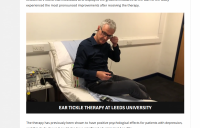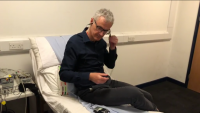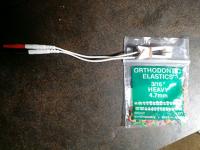S O U R C E : https://eurekalert.o...ol-tc072919.php
Tickling' the ear with a small electrical current appears to rebalance the autonomic nervous system for over-55s, potentially slowing down one of the effects of ageing, according to new research.
Scientists found that a short daily therapy delivered for two weeks led to both physiological and wellbeing improvements, including a better quality of life, mood and sleep.
The therapy, called transcutaneous vagus nerve stimulation, delivers a small, painless electrical current to the ear, which sends signals to the body's nervous system through the vagus nerve.
The new research, conducted at the University of Leeds, suggests the therapy may slow down an important effect associated with ageing.
This could help protect people from chronic diseases which we become more prone to as we get older, such as high blood pressure, heart disease and atrial fibrillation. The researchers, who published their findings today in the journal Aging, suggest that the 'tickle' therapy has the potential to help people age more healthily, by recalibrating the body's internal control system.
Lead author Dr Beatrice Bretherton, from the School of Biomedical Sciences at the University of Leeds, said: "The ear is like a gateway through which we can tinker with the body's metabolic balance, without the need for medication or invasive procedures. We believe these results are just the tip of the iceberg.
"We are excited to investigate further into the effects and potential long-term benefits of daily ear stimulation, as we have seen a great response to the treatment so far."
The study was conducted by scientists from the University of Leeds and funded by the Dunhill Medical Trust.
What is the autonomic nervous system?
The autonomic nervous system controls many of the body's functions which don't require conscious thought, such as digestion, breathing, heart rate and blood pressure.
It contains two branches, the sympathetic and the parasympathetic, which work against each other to maintain a healthy balance of activity.
The sympathetic branch helps the body prepare for high intensity 'fight or flight' activity, whilst the parasympathetic is crucial to low intensity 'rest and digest' activity.
As we age, and when we are fighting diseases, the body's balance changes such that the sympathetic branch begins to dominate. This imbalance makes us more susceptible to new diseases and leads to the breakdown of healthy bodily function as we get older.
Clinicians have long been interested in the potential for using electrical currents to influence the nervous system. The vagus nerve, the major nerve of the parasympathetic system, has often been used for electrical stimulation and past research has looked at the possibility of using vagus nerve stimulation to tackle depression, epilepsy, obesity, stroke, tinnitus and heart conditions.
However, this kind of stimulation needs surgery to implant electrodes in the neck region, with associated expense and a small risks of side effects.
Fortunately, there is one small branch of the vagus nerve that can be stimulated without surgery, located in the skin of specific parts of the outer ear.
In Leeds, previous research has shown that applying a small electrical stimulus to the vagus nerve at the ear, which some people perceive as a tickling sensation, improves the balance of the autonomic nervous system in healthy 30-year-olds.
Other researchers worldwide are now investigating if this transcutaneous vagus nerve stimulation (tVNS) could provide a therapy for conditions ranging from heart problems to mental health.
Diane Crossley, aged 70, from Leeds, took part in the study and received the tVNS therapy for two weeks. She said: "I was happy to be a participant in this really interesting study, it helped me with my awareness of my own health.
"It was a fascinating project and I was proud to be part of it."
In their new study, scientists at the University of Leeds wanted to see whether tVNS could benefit over 55-year-olds, who are more likely to have out-of-balance autonomic systems that could contribute to health issues associated with ageing.
They recruited 29 healthy volunteers, aged 55 or above, and gave each of them the tVNS therapy for 15 minutes per day, over a two week period. Participants were taught to self-administer the therapy at home during the study.
The therapy led to an increase in parasympathetic activity and a decrease in sympathetic activity, rebalancing the autonomic function towards that associated with healthy function. In addition, some people reported improvements in measures of mental health and sleeping patterns.
Being able to correct this balance of activity could help us age more healthily, as well as having the potential to help people with a variety of disorders such as heart disease and some mental health issues.
Additionally, improving the balance of the autonomic nervous system lowers an individual's risk of death, as well as the need for medication or hospital visits.
Researchers found that individuals who displayed the greatest imbalance at the start of the study experienced the most pronounced improvements after receiving the therapy.
They suggest that in future it may be possible to identify who is most likely to benefit from the therapy, so it can be offered through a targeted approach.
tVNS therapy has previously been shown to have positive psychological effects for patients with depression, and this study shows it could also have significant physiological benefits.
Dr Susan Deuchars, one of the senior authors on the study, said: "We believe this stimulation can make a big difference to people's lives, and we're now hoping to conduct further studies to see if tVNS can benefit multiple disorders."
Further studies are now needed to understand what the long-term health effects of tVNS might be, as this study involved a small number of participants over a short time period.
























































